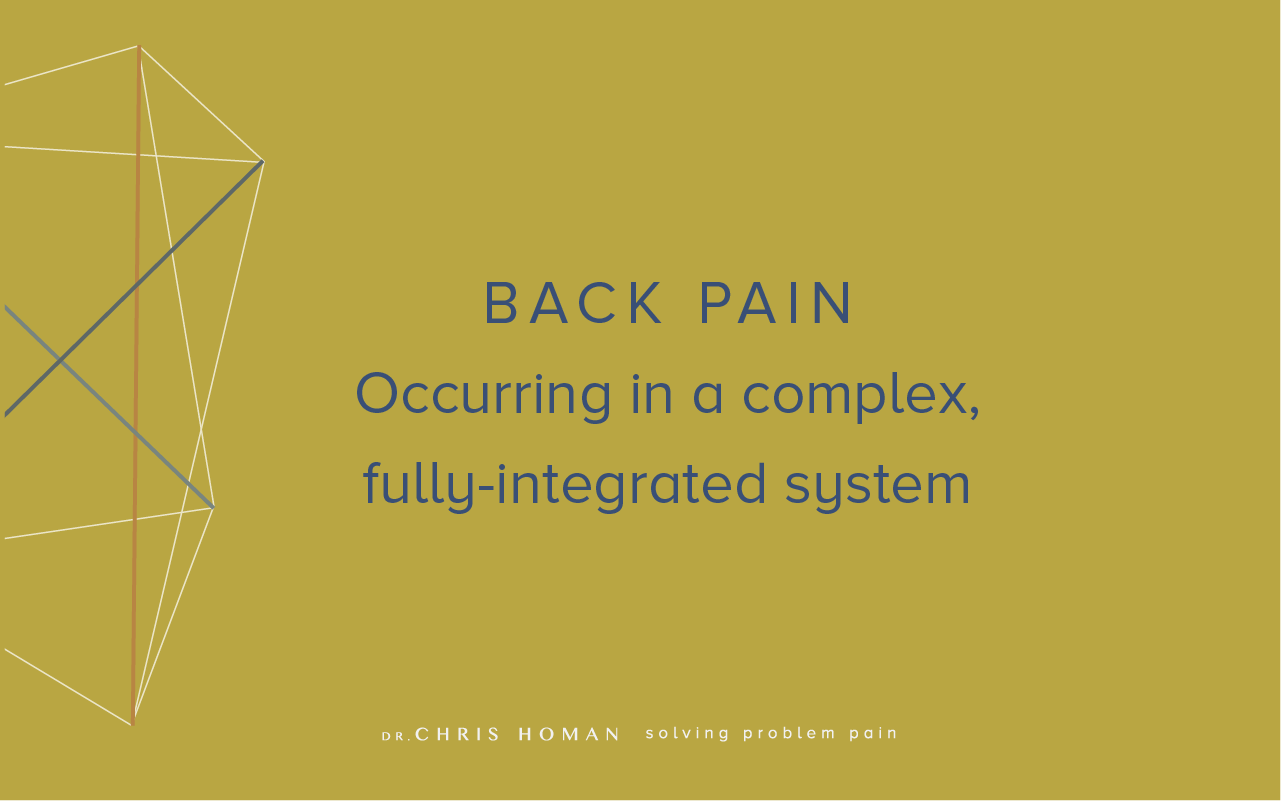The human body is a complex, fully integrated system in which a fibrous web of 600 muscles is draped over the 206 bones of the skeleton. There are multiple interactive control systems that influence the functioning of our bodies. In certain circumstances, a muscle can reset its length receptors and become “shortened” in a persistent way. This is governed by a resetting of the neuromuscular “software” at a spinal level. Sometimes this occurs suddenly when a muscle is activated without warning, e.g. when you miss a step in the dark or are involved in a motor vehicle accident. At other times, the muscle gradually resets its “normal” length in response to habitual use, e.g. sitting slumped at a desk day after day.
When muscle shortening occurs, it tends to alter tensioning across the whole muscle / fascia web. Occasionally this can lead to painful over-stretching of the shortened muscle itself, as it tries to cope with its usual demands on a “shortened leash”. More commonly however, the overload is felt somewhere else across the muscle-fascia web, wherever the capability of the tissues is exceeded. The overloaded muscles try to resist by contracting harder, particularly in their central parts where the motor nerves attach. They form knots of spasm (trigger points) that cause diffuse pain to be referred generally towards where the muscle’s tendon insertions. This potentially severe pain is known as “myofascial pain”.
The pain patterns of individual muscles have been well recognised since Prof Kellgren first reported experiments on his British medical students in the 1930’s (Clin Sci 3:175-190, 1938)! Trigger points and myofascial pain are more likely to occur if the ligaments supporting joints are lax or the muscles are fatigued.
Once the tensioning of the web is “wonky”, it tends to also change the loading across the skeleton that it is draped over. Some joints end up carrying more load and/or changing alignment and are at higher risk of becoming painful. Take note though that if the underlying skeleton is asymmetric, (e.g. up to 10% of people have 10mm or more difference in their leg length), then this has a reverse effect on the muscle / fascia web. In such circumstances, some parts of the web have to continually work harder to compensate and are at higher risk of forming painful trigger points themselves. In yet other circumstances, the joints themselves can become painful (e.g. arthritis), firing off pain circuits and driving secondary changes in muscle function that further contribute to the pain.
However, the situation with body pain is even more complex because of changes in the body’s control systems. If the nerves and their receptors become more sensitised, they are likely to transmit stronger pain signals back to the brain via the spinal cord. This tends to occur naturally when pain signalling persists for any significant length of time (pain wind-up). It can also occur with certain changes in the immune or hormonal systems. On other occasions, spinal nerves become directly irritated as they leave the spine and can cause pain that refers down a limb (e.g. sciatic leg pain caused by a disc prolapse). These irritated spinal nerves can also set up painful secondary trigger points in the muscles they supply, further contributing to the pain.
Pain is also influenced by the brain. Pain is not a sense like vision, where what you see is what you get. Rather pain is an experience, where the signals that are sent back are processed by the brain. Firstly, the brain controls the amount of pain signalling coming via the spinal cord through the process of descending inhibition. Secondly, the primitive, lower parts of the brain (e.g. amygdala) that control emotions then regulate the volume of the signal that is passed up to the cortex of the brain. Finally, it is this higher “thinking” part of the brain that is thought to ultimately define the experience of pain. It is the outcome of all this processing that determines what pain you feel. High emotional stress, depression and sleep deprivation are some things that are known to up-regulate the processing of pain and worsen the pain experience. A person’s thinking has been shown to affect the severity and impact of pain. Even the meaning of pain is important, e.g. pain levels are often much higher if a patient is worried about a sinister cause like cancer (catastrophisation).
Example: low back pain
A patient’s persistent low back pain may be influenced by any or all of the following, (many of which will interact with each other):
- Primary muscle imbalance leading to mal-alignment of the pelvis and lower spine and increased torsion across the joints;
- Irritated spinal joints leading to secondary muscle spasm and pelvic mal-alignment;
- Lax pelvic ligaments allowing excessive joint movement with overload of muscles as they try to provide emergency support to the joints;
- Leg length asymmetry leading to asymmetric loading through the pelvis and spine;
- Referred pain from internal organs (e.g. women’s menstrual pain);
- Abdominal obesity and insulin resistance leading to increased inflammation and sensitisation of nerves;
- Anxiety / hypervigilance increasing muscle firing and amplifying pain circuits.
- Low thyroid hormone or iron levels (reduce energy production in muscles)
Any or all of the above could be present in the one patient, necessitating a whole-of-patient approach. The most effective treatment for each component could include:
- Manual techniques or injections to reset the neuromuscular software;
- Steroid injections to damp down joint irritability;
- Glucose prolotherapy to strengthen the ligaments supporting the joints;
- Heel lift in shoe on short side;
- Hormonal therapy to regulate the menstrual cycle;
- Low carbohydrate diet to improve insulin sensitivity, lose weight and decrease body-wide inflammation;
- Counselling / mindfulness / meditation.
- Prescribing thyroid hormone or iron supplementation.
Summary
Pain is an experience that occurs within the complex, interactive system of the body. Solving problem pain frequently requires a whole-of-person approach that improves the function of multiple, inter-related aspects of the body.
Dr. Chris Homan
MBBS FRACGP FACRRM DRANZCOG PGDipMSM(Otago)

